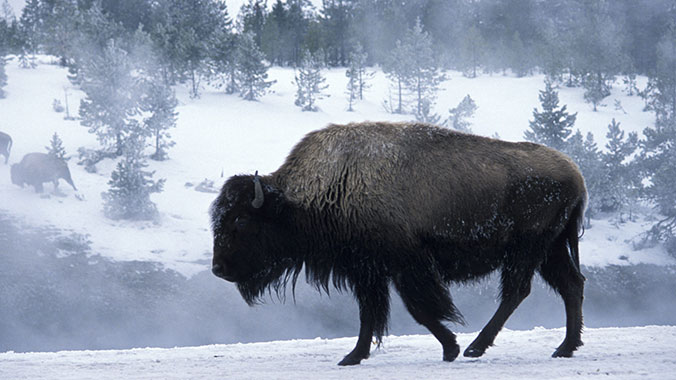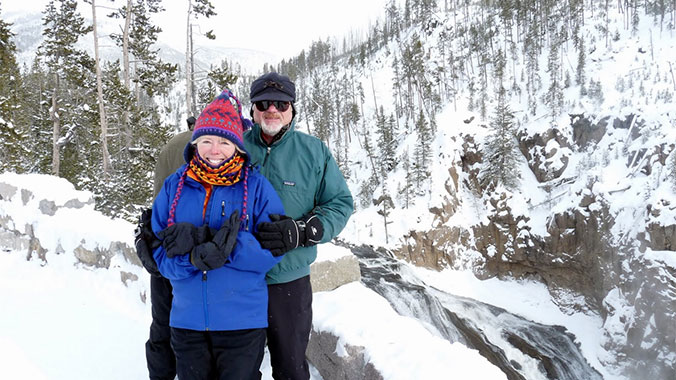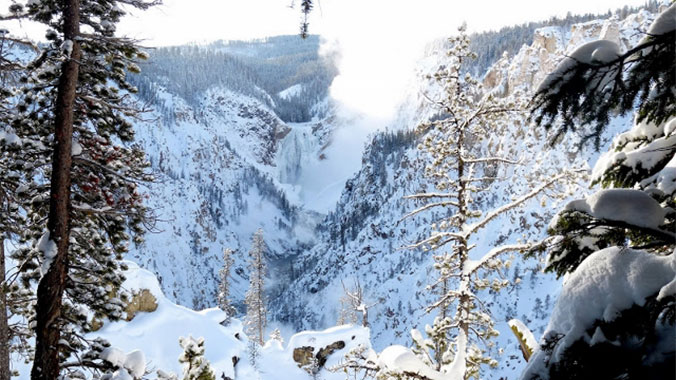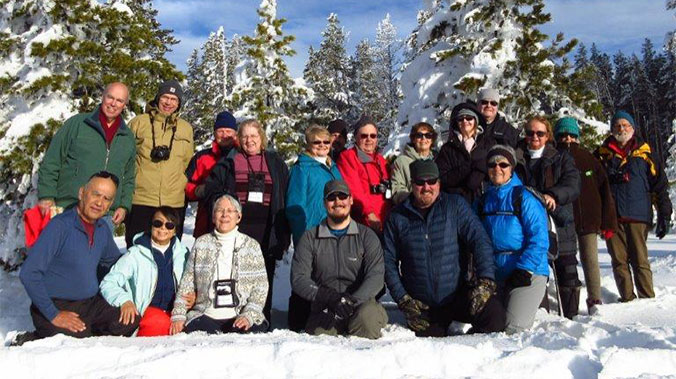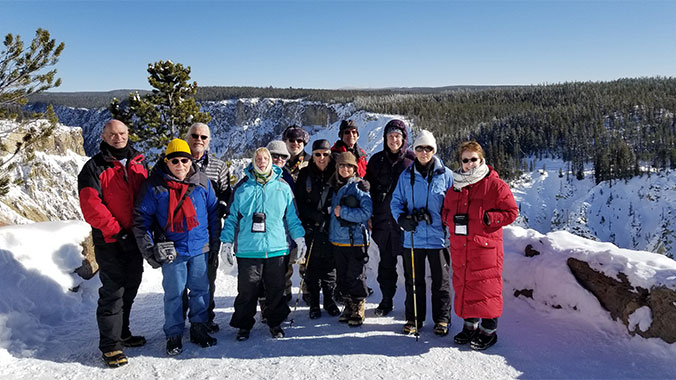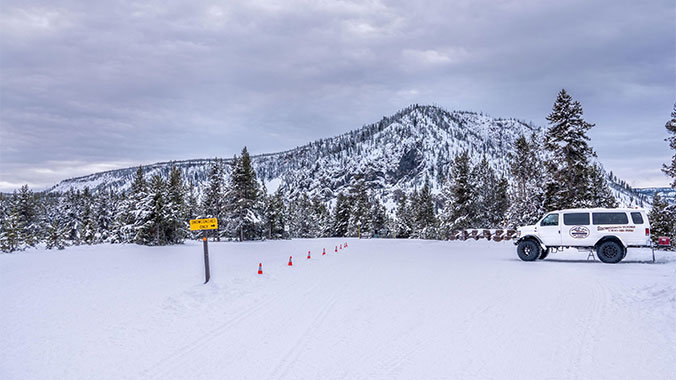Wyoming
Heart of the Winter in Yellowstone
Program No. 21771RJ
Witness Yellowstone National Park in winter as veils of snow create a stunning backdrop for bubbling hot springs, thermal pools, pristine landscapes and the region’s unique wildlife.
Itinerary
While we make every effort to ensure the accuracy of our published materials, programs are typically advertised more than a year prior to their start date.
Read More.
While we make every effort to ensure the accuracy of our published materials, programs are typically advertised more than a year prior to their start date. As a result, some program activities, schedules, accommodations, personnel, and other logistics occasionally change due to local conditions or circumstances. Should a major change occur, we will make every effort to alert you. For less significant changes, we will update you during orientation. Thank you for your understanding.
Duration
7 days
6 nights
What's Included
17 meals (
6B, 5L, 6D
)
2 expert-led lectures
9 expert-led field trips
An experienced Group Leader
6 nights of accommodations
Taxes and customary gratuity
Road Scholar Assurance Plan
Day
1
Check-in, Registration, Orientation, Welcome Dinner
Location:
Bozeman, Montana
Meals:
D
Stay:
Springhill Suites
Activity Note
Hotel check-in from 3:00 p.m.
Afternoon:
Program Registration: 4:00 - 5:00 p.m. After you have your room assignment, come to the Road Scholar table in the lobby to register with the program staff and get your welcome packet containing your up-to-date schedule that reflects any last-minute changes, other important information, and to confirm when and where the Orientation session will take place. If you arrive late, please ask for your packet when you check in.
Dinner:
Catered in the hotel conference room.
Evening:
Orientation. In the hotel conference room, the Group Leader will greet everyone and lead introductions. We will review the up-to-date program schedule, discuss roles and responsibilities, logistics, safety guidelines, emergency procedures, and answer questions. This program is staffed with both a resident instructor who will give lectures and lead field trips and a Group Leader who will deal primarily with logistics. Only “over snow vehicles” are allowed in Yellowstone National Park during the winter months. All of our travel in the park will be via snow coaches — specialized van-type vehicles that travel over snow and ice, moving at slow speed limits (25 mph). During our time in snow coaches, the instructor will provide commentary along the way and at stops to view winter landscapes and wildlife. The snow coaches are heated; however, warm footwear and warm layered clothing are necessary outdoors. Periods in the daily schedule designated as “Free time” and “At leisure” offer opportunities to do what you like and make your experience even more meaningful and memorable according to your personal preferences. The Group Leader will be happy to offer suggestions. Program activities, schedules, personnel, and indicated distances or times may change due to local circumstances/conditions. In the event of changes, we will alert you as quickly as possible. Thank you for your understanding. Continue getting to know your fellow Road Scholars, settle in, and get a good night’s rest for the day ahead. Prepare for check-out and transfer tomorrow.
Day
2
Yellowstone Overview, Museum of the Rockies
Location:
West Yellowstone, MT
Meals:
B,L,D
Stay:
Yellowstone Park Hotel
Activity Note
Some short walks on snow-packed trails. Walking about 1.75 miles; Periods of standing
Breakfast:
At the hotel.
Morning:
Enjoy an introductory lecture given by our instructor. During our morning class time our instructor will put Yellowstone into perspective as we hit the road and discuss some of the geologic processes that have shaped Yellowstone's landscape through the ages. We'll discuss winter ecology, seasonal adaptations as well as tectonic plate movement, the Yellowstone hot spot, and how the Park's unique ecosystem and diverse habitats are a direct result of glaciations, as well as tectonic and volcanic activity. We will check out of our hotel, meet our motorcoach, and transfer to Gardiner MT via the beautiful Paradise Valley.
Lunch:
At a local restaurant.
Afternoon:
We’ll head out after lunch via motorcoach for West Yellowstone, Montana. We'll check into our hotel upon arriving.
Dinner:
At a local restaurant.
Evening:
At leisure. Our Instructor and Group Leader will be available for questions and conversation.
Day
3
Winter Wonderland by Snow Coach, Old Faithful
Location:
Old Faithful, Yellowstone National Park, WY
Meals:
B,L,D
Stay:
Old Faithful Snow Lodge
Activity Note
Getting in/out of heated snow coaches; short walks on snow-packed and sometimes icy trails or boardwalks.
Breakfast:
At the hotel.
Morning:
We will board the snow coaches and begin exploring the parks interior. We'll follow the Madison River to the Upper Geyser Basin, home to the most famous Geyser in the world, Old Faithful. Stops along the way.
Lunch:
In the Park, we’ll have sack lunches.
Afternoon:
We'll travel along the Firehole River. The Firehole River is lined by several geyser basins which make Yellowstone so famous. Delight in the winter scenery as we traverse the park before arriving at Old Faithful.
Dinner:
At the Old Faithful Snow Lodge
Evening:
At leisure. You might like to bundle up and take a short stroll outside under Yellowstone's star-filled sky mid mountain-scented, winter air, or relax at the Lodge.
Day
4
Upper Geyser Basin, Old Faithful
Location:
Old Faithful, Yellowstone National Park, WY
Meals:
B,L,D
Stay:
Old Faithful Snow Lodge
Activity Note
Getting in/out of heated snow coaches; short walks on snow-packed trails.
Breakfast:
At a restaurant near Old Faithful.
Morning:
We'll gather with the instructor for an optional walk around the geyser basin to explore the wonders of this geologic masterpiece. Join the instructor as they reveal what is sitting under this magnificent landscape.
Lunch:
At the Snow Lodge dining room.
Afternoon:
We'll enjoy a quite afternoon around the Snow Lodge, or explore the geyser basin on your own. There are snowshoes and cross country skis available for the more adventurous. Enjoy the quite of the area, or the lodge.
Dinner:
At the Snow Lodge dining room.
Evening:
At leisure.
Day
5
Fountain Paint Pots, Norris geyser basin
Location:
West Yellowstone, MT
Meals:
B,L,D
Stay:
Yellowstone Park Hotel
Activity Note
Getting on and off of the motorcoach. Driving about 95 miles, 4 hours round trip. Stops along the way. Walking up to 1 mile snow-packed and icy boardwalks and paths.
Breakfast:
At a local restaurant.
Morning:
We'll board our snowcoaches and return to West Yellowstone. There are plenty of geyser basins along the way to explore and enjoy the serenity of winter on the Yellowstone plateau, learning along the way.
Lunch:
Sack lunches in the park.
Afternoon:
We'll continue our exploration of this winter wonderland while returning to West Yellowstone via Snowcoach. Check in to the Lodge upon arrival.
Dinner:
At a local restaurant.
Evening:
At leisure. After a long day of adventure, enjoy some relaxation.
Day
6
Grizzly and Wolf Center, return to Bozeman
Location:
Bozeman, Montana
Meals:
B,L,D
Stay:
Springhill Suites
Activity Note
Getting on/off a bus. Driving about 150 miles; approximately 2 hours one way, Walking about 1 mile through the day; packed snow and ice on trails, snow-packed parking areas.
Breakfast:
At a local restaurant.
Morning:
Following breakfast, we will walk to the Grizzly & Wolf Discovery Center where we will learn about the wildlife of Yellowstone, predator and prey relationships, habitat requirements, winter range areas, animal populations, and more. The Grizzly & Wolf Discovery Center is dedicated to providing visitors with a unique opportunity to learn about, view, and ultimately appreciate grizzly bears and gray wolves.
Lunch:
At a local restaurant.
Afternoon:
We will board our bus and head back to Bozeman via the Gallatin Canyon. Enjoy the views before checking in.
Dinner:
Catered by a local restaurant.
Evening:
In the hotel's conference room we’ll gather one last time as a group with our Instructor who will review our grand adventure in Yellowstone’s winter wonderland. We’ll have time for any final questions and answers. Prepare for check-out and departure in the morning. Advance reservations required for airport shuttle (not included in program price).
Day
7
Program Concludes
Location:
Bozeman, Montana
Meals:
B
Activity Note
If you made an advance reservation for the airport shuttle, it departs from outside the hotel at 8:30 a.m. Hotel check-out by 11:00 a.m.
Breakfast:
At the hotel.
Morning:
We hope you enjoy Road Scholar learning adventures and look forward to having you on rewarding programs in the future. Please join our Facebook page and share photos of your program. Visit us at www.facebook.com/rsadventures. Best wishes for all your journeys!
Please select a day to update the map
Map details are not available for this location.

